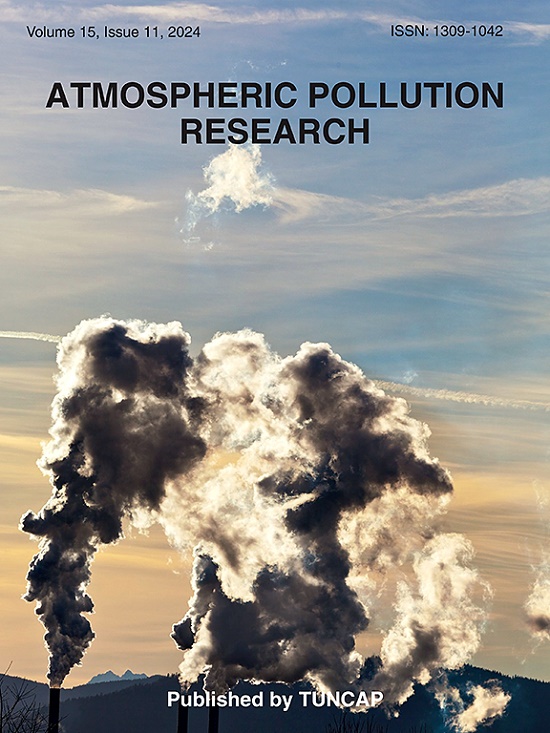波斯湾北部马赫沙赫尔经济特区空气中微塑料的特征和暴露评估
IF 3.5
3区 环境科学与生态学
Q2 ENVIRONMENTAL SCIENCES
引用次数: 0
摘要
大气微塑料(MPs)由于其微小的尺寸和潜在的健康影响,已成为人类面临的最大环境和健康挑战之一。这些颗粒很容易被吸入,使它们绕过人体最初的呼吸防御进入肺泡。这些颗粒一旦进入肺泡,就会对健康造成各种负面影响,可能导致呼吸系统问题和其他系统性健康问题。这项研究首次量化了伊朗胡齐斯坦省马赫沙赫尔市大气微塑料的时空分布。测量是在一年中的两个月,在三个不同的地点进行的,为期12个时段,每次24小时采样:住宅区,高交通量和工业区。室内和室外空气中MPs的浓度在三个采样点之间存在差异:其范围为0.16至1.11颗粒/m3,住宅区、高交通量和工业区的平均值分别为0.47±0.06、0.78±0.07和0.85±0.09颗粒/m3。工业区的污染物浓度最高,其次是交通繁忙的地区和住宅区。室内空气中也含有显著的MP浓度。就其颜色和形状而言,大多数MPs被鉴定为黑灰色纤维(69.2 - 81.6%),尺寸大多小于500 μm,尽管也存在较大的颗粒(>1000 μm)。此外,拉曼光谱分析显示,最普遍的塑料类型是聚乙烯(PE),聚苯乙烯(PS),聚丙烯(PP)和尼龙。本研究中微塑料的丰度可归因于该地区石化工业的初级塑料生产。我们的结果可归因于位于该地区的石化工业的初级塑料生产。吸入风险评估显示,不同年龄组的MP吸入暴露存在显著差异,新生儿和婴儿面临的风险最高(0.44 MP/kg体重/天,其次是婴儿0.23 MP/kg体重/天,成人0.07 MP/kg体重/天)。这项研究有助于更好地了解大气中多聚氰胺的行为,并强调需要进一步研究以评估与多聚氰胺暴露相关的潜在健康风险。本文章由计算机程序翻译,如有差异,请以英文原文为准。

Characterization of airborne microplastics and exposure assessment in the Mahshahr special economic zone, Northern Persian Gulf
Atmospheric microplastics (MPs), due to their diminutive size and potential health impacts, have become one of the biggest environmental and health challenges facing humanity. These particles can be easily inhaled, allowing them to bypass the body's initial respiratory defenses and enter the lung alveoli. Once lodged in the alveoli, these particles can cause various negative health effects, potentially leading to respiratory issues and other systemic health problems. This study marks the first quantification of atmospheric microplastics' spatial and temporal distribution in Bandar Mahshahr, Khuzestan, Iran. Measurements were conducted over twelve periods of 24-h sampling across two months of the year at three different sites: residential, high-traffic, and industrial areas. The concentration of MPs in the indoor and outdoor air varied across the three sampling sites: it ranged from 0.16 to 1.11 particles/m3, with mean values of 0.47 ± 0.06, 0.78 ± 0.07, and 0.85 ± 0.09 particles/m3 for residential, high-traffic, and industrial areas, respectively. Industrial areas had the highest MP levels, followed by high-traffic and residential sites. Indoor air also contained significant MP concentrations. Regarding their color, and shape, the majority of MPs were identified as black-gray fibers (69.2–81.6 %) with sizes mostly below 500 μm, though larger particles (>1000 μm) were also present. Moreover, Raman spectroscopic analysis revealed that the most prevalent types of plastics were polyethylene (PE), polystyrene (PS), polypropylene (PP), and nylon. The abundance of microplastics in present study can be attributed to the primary production of plastics by petrochemical industries located in the area. Our results can be attributed to the primary production of plastics by petrochemical industries located in the area. The inhalation risk assessment showed a significant disparity in MP inhalation exposure across different age groups, with newborns and infants facing the highest (0.44 MP/kg body weight/day, followed by infants at 0.23 MP/kg body weight/day, and adults at 0.07 MP/kg body weight/day). This study contributes to a better understanding of MP behavior in the atmosphere and emphasizes the need for further research to assess the potential health risks associated with MP exposure.
求助全文
通过发布文献求助,成功后即可免费获取论文全文。
去求助
来源期刊

Atmospheric Pollution Research
ENVIRONMENTAL SCIENCES-
CiteScore
8.30
自引率
6.70%
发文量
256
审稿时长
36 days
期刊介绍:
Atmospheric Pollution Research (APR) is an international journal designed for the publication of articles on air pollution. Papers should present novel experimental results, theory and modeling of air pollution on local, regional, or global scales. Areas covered are research on inorganic, organic, and persistent organic air pollutants, air quality monitoring, air quality management, atmospheric dispersion and transport, air-surface (soil, water, and vegetation) exchange of pollutants, dry and wet deposition, indoor air quality, exposure assessment, health effects, satellite measurements, natural emissions, atmospheric chemistry, greenhouse gases, and effects on climate change.
 求助内容:
求助内容: 应助结果提醒方式:
应助结果提醒方式:


